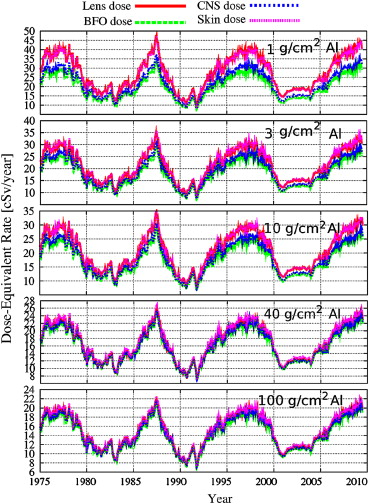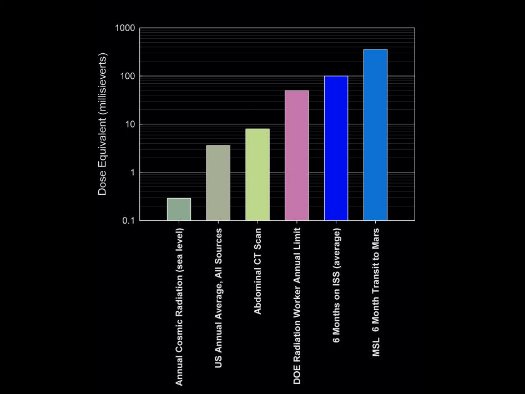Space is a hazardous place! That’s the conclusion of the research published today in the journal Science. NASA gathered the data from Curiosity’s long flight from Earth to Mars and the results show that the radiation risk factor is very high for any human who chooses to go on a mission to the Red Planet. When Curiosity was crossing from Earth to Mars its detectors picked up an average of 1.8 millisieverts of radiation per day. That’s equivalent to what we humans get exposed to on Earth in approximately half a year.
The logarithmic histogram below compares cosmic radiation exposure from different sources. Note the exponential increase in exposure experienced by human crews on the International Space Station when compared to what we humans deal with here on the planet. One six month stay on the ISS equals 33 years here on Earth.
With the current technology being considered for missions to Mars like those announced by Mars One and Dennis Tito’s Inspiration Mars Foundation it is clear that a one-way trip will expose human crews to much more than ISS crews, in fact, over 330 millisieverts, equivalent to 110 years of exposure on Earth. For a return trip double the radiation exposure, and then add to that the doses received while on Mars or in orbit around the planet.
We know that exposure to radiation can lead to increased cell mutations and cancer. Exposure to 1 sievert over a lifetime equals a 5% increase in cancer risk. Current NASA astronauts are career limited after exposures equaling 3% risk.
What is the source of all of this space radiation? Most comes from charged particles emitted by the Sun. Solar flares and coronal mass ejections fry satellites, so imagine what these fairly regular solar incidents can do to the innards of an astronaut on a spacewalk, or even while inside the relative safety of a spacecraft. Today human crews aboard the ISS get constantly monitored for radiation exposure and they have the advantage of the relative safety provided by the Earth’s magnetic field which deflects many of the charged particles.
Now imagine the danger in Deep Space where Earth’s magnetic field can provide no protection. All we have is a shielded spacecraft today similar to the one that encased Curiosity. On its journey Curiosity didn’t just feel the Sun’s radiation. It was exposed to high energy cosmic rays emanating from supernovas occurring throughout the Milky Way Galaxy. These particles are a much greater threat, far more energetic than those emitted by the Sun. No shielding we currently design can stop them.
How then do we protect humans venturing into space? We might be able to devise better shielding using water. Hydrogen can be a great buffer to cosmic rays. But a better solution would be to cut the time it takes to get from Earth to Mars. This means ending our dependence on chemical propulsion systems once beyond Earth orbit. We have solutions like NERVA and VASIMIR, nuclear-propulsion systems that have been on NASA drawing boards for years. If we want Mars to be a place that healthy humans can explore and eventually settle then these are the systems that need development. Cutting the time it takes from 180 days to 30 is literally a matter of life and death.










